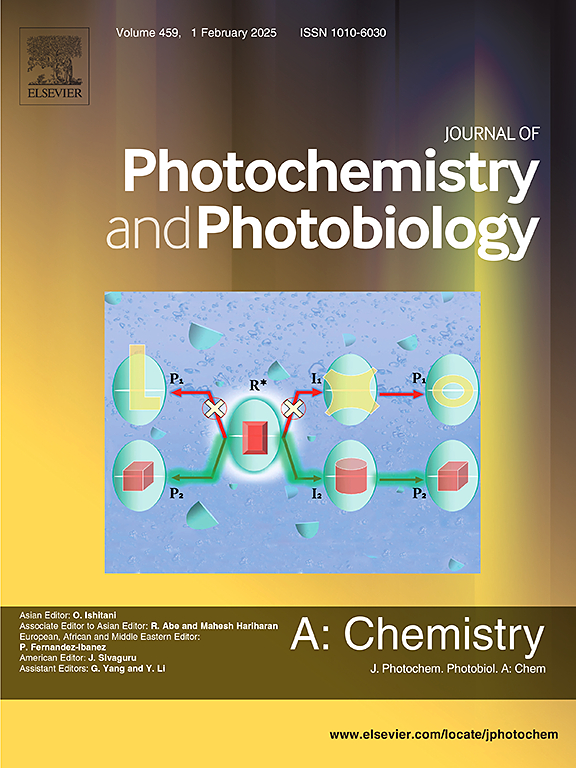In-Situ generation of nano TiO2 from MIL-125(Ti) and its role in boosting the photocatalytic degradation of tetracycline hydrochloride
IF 4.1
3区 化学
Q2 CHEMISTRY, PHYSICAL
Journal of Photochemistry and Photobiology A-chemistry
Pub Date : 2024-10-20
DOI:10.1016/j.jphotochem.2024.116103
引用次数: 0
Abstract
Metal-organic frameworks (MOFs), such as MIL-125(Ti), are advanced photocatalytic materials due to their tunable compositions and functionalities. However, their practical application in photocatalysis is often limited by their wide bandgap and the inherent structural instability. This study presents a strategy to improve the photocatalytic performance of MIL-125(Ti) by hydrothermal reaction combined with an in-situ decomposition to generate nano TiO2, creating a composite with g-C3N5 nanosheets. The obtained composite exhibited a rate constant of 0.00122 min−1 mg−1 for the degradation of tetracycline hydrochloride under visible light irradiation, which is 24.4 and 20.3 times that of g-C3N5 and MIL-125(Ti), respectively. Characterization results indicated the formation of an effective composite structure that improved the separation efficiency of photogenerated carriers and promoted the generation of reactive oxygen species. The in-situ generated TiO2 within the MIL-125(Ti)/g-C3N5 composite during the preparation and photocatalysis processes not only compensated for the structural damage to the original MIL-125(Ti) but also significantly enhanced its degradation performance under visible light. The recyclability and stability of the composite material were also demonstrated, highlighting its potential for practical photocatalytic applications.

利用 MIL-125(Ti)原位生成纳米 TiO2 及其在促进盐酸四环素光催化降解中的作用
金属有机框架(MOFs),如 MIL-125(Ti),因其可调整的成分和功能而成为先进的光催化材料。然而,它们在光催化领域的实际应用往往受到其宽带隙和固有结构不稳定性的限制。本研究提出了一种提高 MIL-125(Ti)光催化性能的策略,即通过水热反应结合原位分解生成纳米 TiO2,并与 g-C3N5 纳米片形成复合材料。得到的复合材料在可见光照射下降解盐酸四环素的速率常数为 0.00122 min-1 mg-1,分别是 g-C3N5 和 MIL-125(Ti) 的 24.4 倍和 20.3 倍。表征结果表明,形成的有效复合结构提高了光生载流子的分离效率,促进了活性氧的生成。在制备和光催化过程中,MIL-125(Ti)/g-C3N5 复合材料中原位生成的 TiO2 不仅弥补了原有 MIL-125(Ti) 结构的损伤,还显著提高了其在可见光下的降解性能。该复合材料的可回收性和稳定性也得到了证实,凸显了其在实际光催化应用中的潜力。
本文章由计算机程序翻译,如有差异,请以英文原文为准。
求助全文
约1分钟内获得全文
求助全文
来源期刊
CiteScore
7.90
自引率
7.00%
发文量
580
审稿时长
48 days
期刊介绍:
JPPA publishes the results of fundamental studies on all aspects of chemical phenomena induced by interactions between light and molecules/matter of all kinds.
All systems capable of being described at the molecular or integrated multimolecular level are appropriate for the journal. This includes all molecular chemical species as well as biomolecular, supramolecular, polymer and other macromolecular systems, as well as solid state photochemistry. In addition, the journal publishes studies of semiconductor and other photoactive organic and inorganic materials, photocatalysis (organic, inorganic, supramolecular and superconductor).
The scope includes condensed and gas phase photochemistry, as well as synchrotron radiation chemistry. A broad range of processes and techniques in photochemistry are covered such as light induced energy, electron and proton transfer; nonlinear photochemical behavior; mechanistic investigation of photochemical reactions and identification of the products of photochemical reactions; quantum yield determinations and measurements of rate constants for primary and secondary photochemical processes; steady-state and time-resolved emission, ultrafast spectroscopic methods, single molecule spectroscopy, time resolved X-ray diffraction, luminescence microscopy, and scattering spectroscopy applied to photochemistry. Papers in emerging and applied areas such as luminescent sensors, electroluminescence, solar energy conversion, atmospheric photochemistry, environmental remediation, and related photocatalytic chemistry are also welcome.

 求助内容:
求助内容: 应助结果提醒方式:
应助结果提醒方式:


